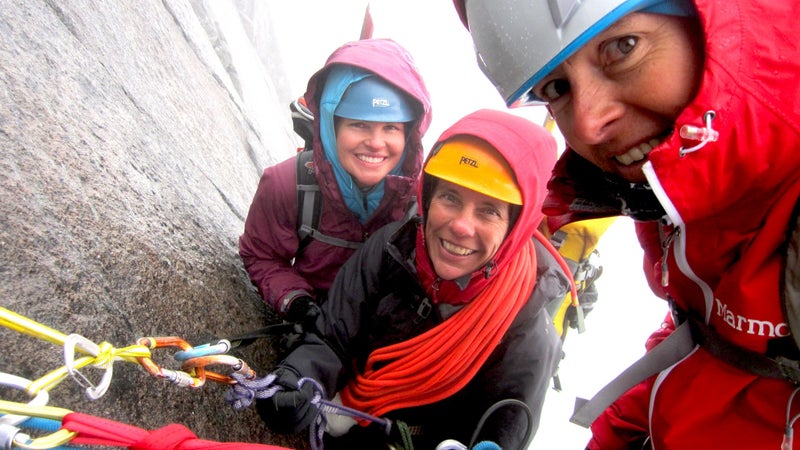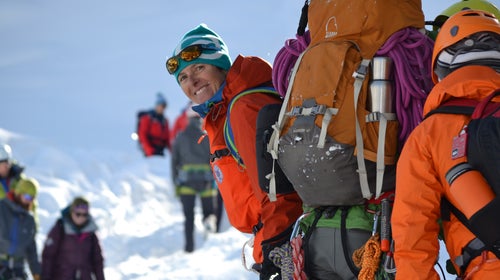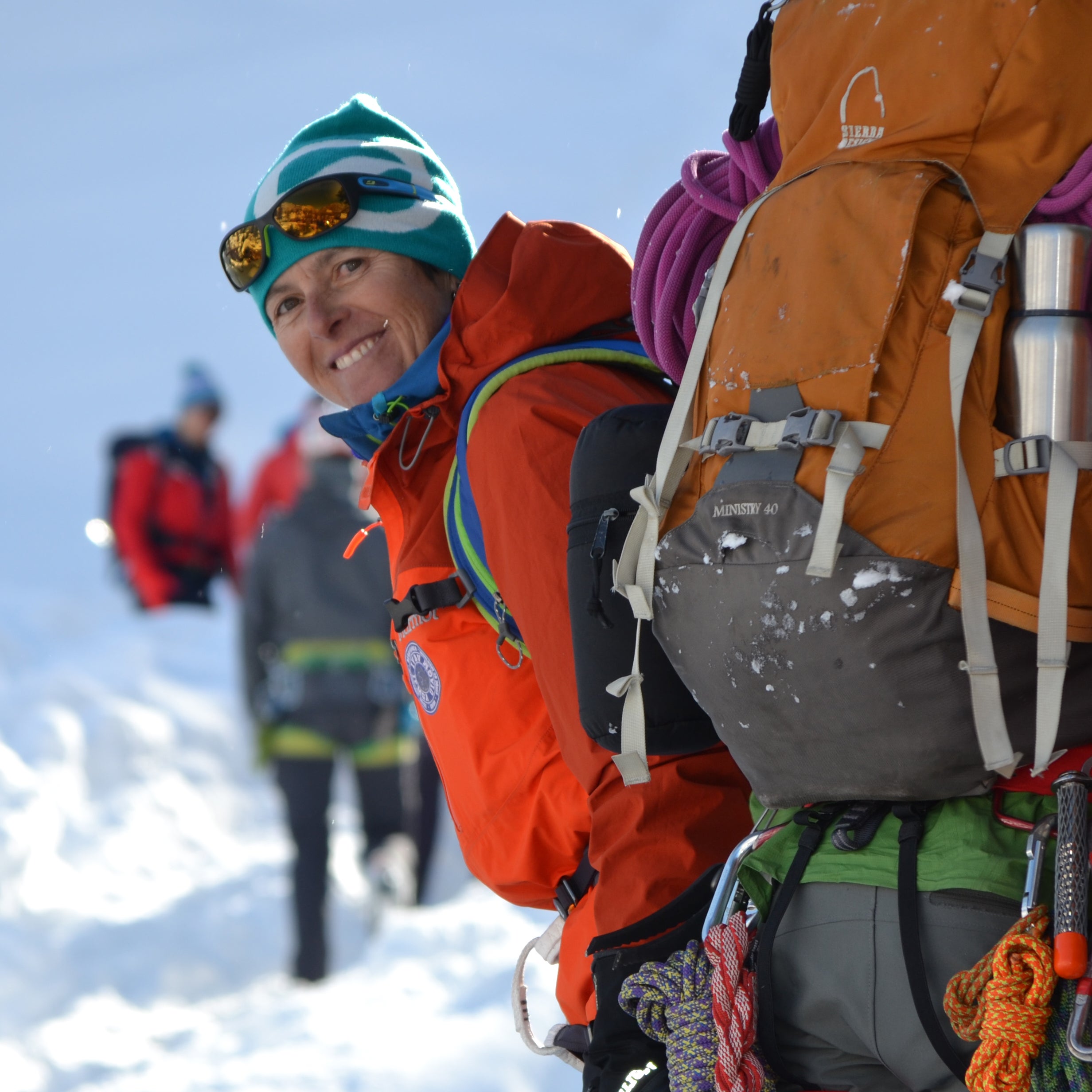In August 1982, and seven other Prescott College freshmen began compulsory wilderness orientation. Raised in West Virginia, Hawse figured the class would be a preview of Arizona’s mountains. Instead, she discovered a calling that’s taken her to peaks around the world.
“Our instructor seemed happier than anyone I’d ever met,” says Hawse. “His goal was to turn everybody on to the outdoors. I wanted to be that happy.”
After graduating in 1986, Hawse signed on as an outdoor education instructor at Prescott. She spent five of the next six years coaching students to ski mountain faces, kayak whitewater rapids, and climb technical cliffs. “Those trips are where everything started,” Hawse says.
Twenty-five years later, Hawse has led clients in the , , , and , as well as the , Canadian Rockies, and Antarctica. In 2010, she became the sixth American woman to be certified by the , the highest level a mountain guide can achieve. She .
“Guiding made me who I am,” Hawse says. “It gave me confidence and taught me to think on my feet. I really can’t imagine having a different job.”
Age: 54
Job: ; instructor; avalanche forecaster for ; sponsored alpinist with , ,��, , and ; co-owner of , which offers climbing and skiing trips for women.
Hometown: Elkins, West Virginia
Home Base: Ridgway, Colorado
Education: Bachelor of arts degrees in natural history and outdoor education, plus a master of arts in international mountain conservation, from Prescott College.
Motto: “Alex Lowe said that the best climber is the one having the most fun. I try to apply that maxim to every part of my life. Don’t forget to breathe, balance, and believe.”
Figuring Out Her Style: “I had second thoughts about guiding in the early 1990s. I just burned out. I worked as a carpenter for a year, but being away from guiding made me realize how much I loved teaching clients. I started getting into technical mountaineering trips. Since then, I’ve never looked back.”
Hard Truths About Guiding: “You shouldn’t become a guide if you’re just looking for a career that allows you to ski and climb full-time. Guiding means providing a safe, rewarding experience for your clients, so you’ve gotta enjoy interacting with new people. Really, I’m a teacher.”
How to Gain Experience: “Most guides I know work for companies so they don’t have to worry about attracting clients or getting public land permits and insurance. In the United States, independent guides have a tough time with those three things, especially in the beginning. Start at a company and gain skills, connections, and a reputation that will allow you to branch out. At that point, if you want to go solo, you can secure permits and insurance through the certified guide cooperative and market yourself online. Even IFMGA guides work for other companies or go abroad to Europe or Canada, where there are fewer restrictions on land permits.”

Being (and Staying) the Best: “You’ll need a solid background in the type of guiding you’re pursuing, and the consequences are huge if you don’t stay up to date. Technology is starting to change quickly in this field, so you’ve got to embrace the new tools in GPS navigation and emergency response. If you want to guide on snow, stay on top of your weather forecasting skills—being an AMGA instructor keeps me sharp, but I also go to clinics and workshops, plus read lots of scientific reports.”
Turning Hurdles into Learning Opportunities: “Guiding isn’t constant bliss. Don’t look at hurdles as setbacks—think of them as opportunities to grow your skill set. For example, when I decided I wanted to be an avalanche forecaster, I had to take a course and train. My only true hurdle has been physical—as a small woman, I have to work doubly hard to stay super strong.”
No Boring Days: “Guiding will never be nine to five and Monday through Friday, but that’s why it’s exciting. I guide five or so days each week in the winter, plus get up at 4:30 a.m. to forecast avalanche conditions at . When the snow melts, I start getting ready for rock climbing season.”
Daily Ritual: “Morning espresso, checking the weather, and 20 minutes of calisthenics before I meet up with my clients. Get up early. You’ll always need to tinker with your pack before heading out in the morning.”
Workspace Setup: “I have a super-organized gear shed. That’s pretty mandatory. I also have a home gym for high-impact workouts and trip prep.”
Favorite Mountain Gear: “That’s a hard call for a guide! I’ve gotta say footwear—it’s so important to have the right boots for the job. I have shoes for trail running, rock climbing, ski mountaineering, alpine climbing, trekking. You can’t imagine how many pairs I own.”
Work-Life Balance: “Get in the ‘I’m going to work for two weeks, and then have me-time for two weeks’ mind frame. Family life is key, so find a partner who supports your rocky lifestyle.”
Finding Time for Exploration: “I plan my schedule way in advance. This September, I’m taking clients to Chile for heli-skiing. After I finish guiding them, I’ll stay and do the climbs that interest me. There are lots of little opportunities like that.”
The Future of Guiding: “I think the field will continue to grow. Ten or so years ago, people started realizing how important professional leadership is in the mountains. When I started, guides worked seasonally. Now there are lots of year-round positions. Plus, clients are willing to pay more, so it’s possible for guides to live comfortably. But I think most guides will continue to work for companies. It won’t be like Europe, where clients often hire certified freelance mountaineers.”
Credentials Matter: “Certification should be required to work as a mountain guide—you’re responsible for your clients’ lives. Canada and the European countries require guides to have credentials, and I bet the United States will too, eventually. A trustworthy alpine guide will have AMGA, wilderness first responder, and CPR certifications, plus . It takes a long, long time to become an IFMGA guide, but that’s the gold standard.”


